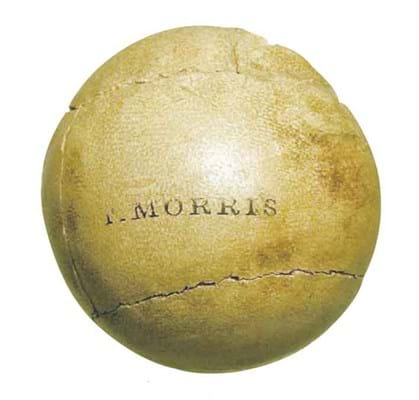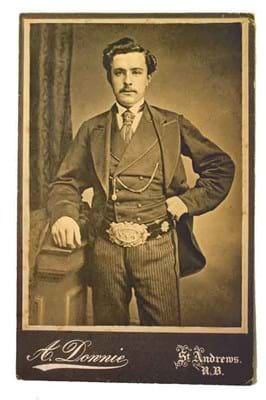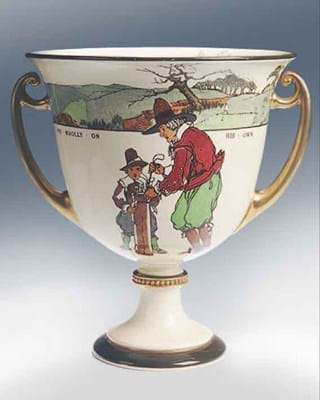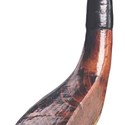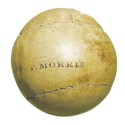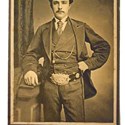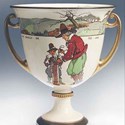With sales timed to coincide with the Open taking place at St Andrews, the demand, as usual, tended to focus on quality items, whereas the course for the middle and lower end was noticeably more hazardous.
Golf specialist at Lyon & Turnbull (19.5% buyer's premium) Rachel Doerr described the sale in Edinburgh on July 11 as a "tough day", adding: "Although the good and unusual lots sell, the general feeling is we need to get new people into the market."
Golf collecting has indeed become a small world with many of its aging members acquainted to each other and holding regular get-togethers.
"They're one of the nicest sets of buyers you could hope for," said Rachel Doerr, who admitted organising a dinner for her clients the night before the sale. Most of these golfing enthusiasts had come over to watch the Open, and some chose to leave commission bids so they would be able to attend the tournament in person.
Pricey Putter
The headline lot was a classic Philp putter with a great provenance. It had been owned by pioneer golfer and ball maker Old Tom Morris and his son Young Tom and it duly brought out one of the market's traditional big spenders - Jaime Ortiz Patino, owner of Spain's Valderama Golf Club.
Senor Ortiz Patino has not made his presence felt in the recent market the way he did five years ago, but does occasionally bid if the right lot comes up. The putter had been part of the Harry B. Wood collection which was given to the North Manchester Golf Club. It was acquired from the club in 1985 by the current vendor, American collector Frank Hardison.
Now in his 80s, Mr Hardison is slowly feeding his collection onto the market and this club came with a letter detailing how he had been able to buy the Wood collection with the help of the UK collector Peter Crabtree.
The fact that it could be proved that the club originated in the UK meant that it was not subject to the import VAT of five per cent that would be have been the case for an American club.
The Philp club was pictured in Wood's book Golfing Curios and the Like and was in excellent condition.
On the day, it was bought on behalf of the Valderama Golf Club by dealer Titus Kendall who had to go to £70,000, the lower estimate, to outbid the other interested party.
"This is a unique piece of golfing history and I would have been willing to bid more for the club," he said after the sale. "It will be on loan to the Valderama Museum where visitors will be able to see the club."
Elsewhere in the sale, two large pieces of Royal Doulton from the same source, part of the well-known series decorated with golfing images, both made high prices for ceramics, but nevertheless fell below their low estimates.
The 8.25in (21cm) high punch bowl, estimated at £5000-6000, sold at £4000 and the two-handled vase, 11in (28cm) diameter, estimated at £7000-10,000, made £6500.
The sale's selling rate of 57 per cent further illustrated the slowdown in the market that has existed over the last five five years and appears to be continuing.
The July 12 auction held by Mullock Madeley (15% buyer's premium) had a slightly higher selling rate at 66 per cent and showed that for smaller salerooms there is certainly still decent money to be made from golf sales.
The Shropshire auctioneers held their sale at The Blyth Hall, a fine 19th century building in Newport on Tay, six miles from St Andrews.
The hammer total of £85,600 was a house record for a golf sale and John Mullock toldATGthat he plans to repeat the excursion North of the Border next year.
He reported a healthy turnout of American and Canadian collectors, who, he said, "had not been seen in such numbers since before 9/11", and, indeed, the majority of lots that made over £500 went to the US.
However, given the volume of golfiana on offer at this time of the year, buyers were allowed to pick and choose. Some good prices though were seen for items relating to Old Tom Morris.
Top Golf Ball
The top lot was a fine Tom Morris feathery golf ball which was contested to £9600 between two American collectors. The buyer was a New Yorker, who outbid a rival from Florida.
The ball was in good condition with closed stitching to the seams and only two slight strike marks. The stampmark was also particularly clear.
Mr Mullock thought the ball must have dated from the 1840s to 1860s, probably during the transitional phase when Old Tom was also making the new gutty balls.
Although he switched his attention mainly to the gutty, and in so doing fell out with fellow ball maker Allan Robertson who was much less enthusiastic at the innovation, Morris did not abandon the feathery altogether. Other Morris memorabilia included an early Tom Morris St Andrews longnose club.
In decent condition, although having undergone some minor work to the neck and face, it made £900. Also a rare studio photograph of Young Tom Morris wearing the Open championship belt after winning the tournament for the third time in a row made £1600.
The sale also included a selection of programmes of which the highlight was consigned from the US. This was a copy of the programme for the first Masters tournament in Augusta in 1934.
The course had opened the year before in 1933 and the inaugural Masters (called "the National Golf Club Invitation Tournament") was won by Horton Smith, who took 284 strokes from the four rounds, four under par. With its original green bound boards, the programme was in excellent condition throughout and an American collector went to £4900 to secure it.


